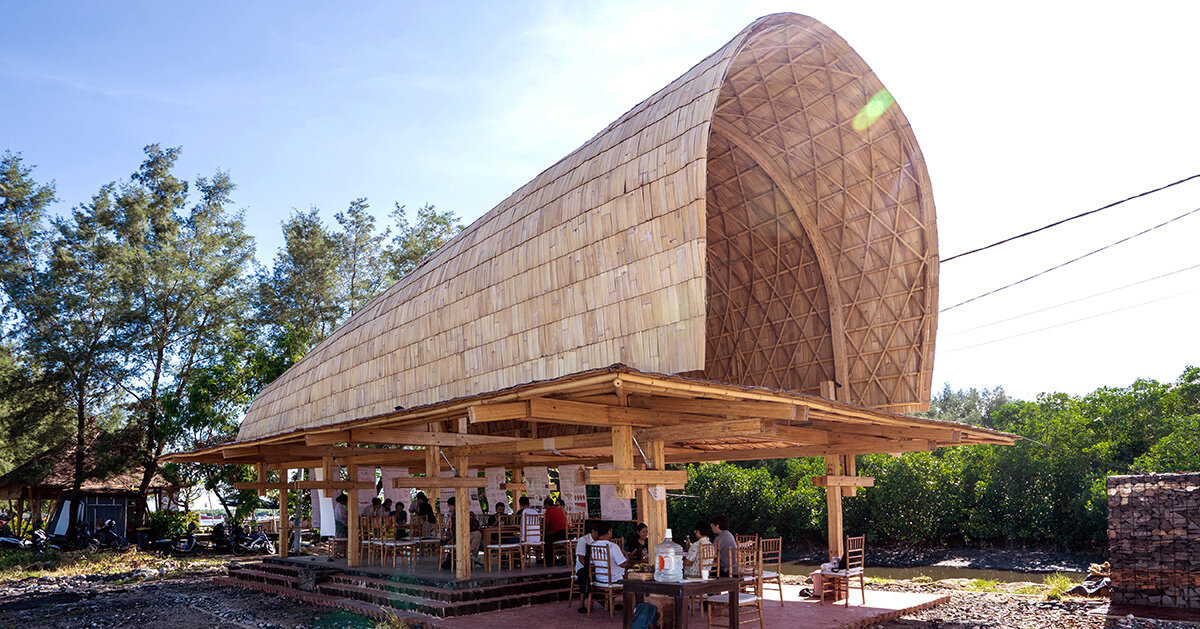BALEBIO PIONEERS CARBON-NEGATIVE ARCHITECTURE IN BALI
BaleBio, a bamboo pavilion designed by Cave Urban for Bauhaus Earth’s ReBuilt initiative, pioneers carbon-negative architecture in Bali while reimagining the traditional communal spaces of the island for a changing climate. Rising above the sands of Mertasari Beach in Denpasar, the 84-square-meter structure transforms a disused car park into a living community hub, an open meeting space that merges environmental performance with social purpose.
In a city where coastal construction is often driven by tourism, BaleBio serves as a prototype for buildings that store carbon instead of emitting it and that house collective needs. Its design draws on the Bale Banjar, the traditional village hall central to Balinese social life, reinterpreting its open and inclusive layout through contemporary engineering and a new understanding of ecological responsibility.

all images by Iwan Sastrawan for Bauhaus Earth
barrel-vaulted roof shades the BAMBOO PAVILION
The sweeping, barrel-vaulted roof of the pavilion rises 8.5 meters above the beach. Crafted by the multidisciplinary design studio Cave Urban for the Bauhaus Earth research institution from slender bamboo rafters and clad in pelupuh (flattened bamboo), the canopy offers natural ventilation and passive cooling. Beneath it, a structural frame of laminated petung bamboo, locally sourced, resin-bonded, and compressed, delivers the strength and precision of steel or timber without the associated carbon cost.
All components were grown, processed, and assembled in Indonesia, establishing a circular supply chain. Construction combined traditional joinery techniques with precision-engineered fittings. Locally sourced volcanic rock, lime plaster, and repurposed terracotta roof tiles contribute to thermal mass and reduce embodied energy, integrating bio-based, geo-based, and reused materials into a coherent system.

designed by Cave Urban for Bauhaus Earth’s ReBuilt initiative
from cradle to construction: beyond zero emissions
A life cycle assessment conducted by environmental engineering consultancy Eco Mantra confirmed BaleBio as verifiably carbon-negative from cradle to construction. The project records an 110% reduction in embodied carbon compared with a conventional build, saving over 53 tonnes of carbon dioxide emissions, equivalent to planting more than 2,400 trees. In quantitative terms, its carbon outcome stands at –5,907 kilograms of carbon dioxide equivalent against a baseline of nearly 60,000 kg.
This rigorous evaluation extends the impact of the project beyond aesthetics or symbolism. By treating the building itself as a test case for a new value chain, Bauhaus Earth and its partners demonstrate the feasibility of carbon-negative construction at an architectural, social, and industrial scale.

this bamboo pavilion pioneers carbon-negative architecture in Bali
a regenerative anchor for local life
Since opening, BaleBio has become a gathering point for residents and visitors alike. What was once a neglected urban plot has turned into a public stage, classroom, and meeting place, reactivating local participation through design. The project’s collaborative process, with contributions from Warmadewa University, community organizations, and local artisans, makes sure that the pavilion remains rooted in its cultural context even as it experiments with global standards of sustainable construction.
For its combined achievements in material innovation, carbon performance, and civic value, BaleBio received three major international distinctions in 2025: the Australian Good Design Award for Social Impact, a commendation from the Built by Nature Prize, and Gold in Excellent Architecture at the German Design Award in the Circular Design and Fair & Exhibition categories.
These accolades highlight the broader ambition of the project to redefine what good design means in an age of climate urgency. BaleBio is part of Bauhaus Earth’s ReBuilt initiative, which seeks to catalyze systemic change in the construction industry through applied research, bio-based materials, and the development of cities as natural carbon sinks.

the sweeping, barrel-vaulted roof of the pavilion rises 8.5 meters above the beach

the design draws on the Bale Banjar

reimagining the traditional communal spaces of the island for a changing climate

crafted from slender bamboo rafters and clad in pelupuh

